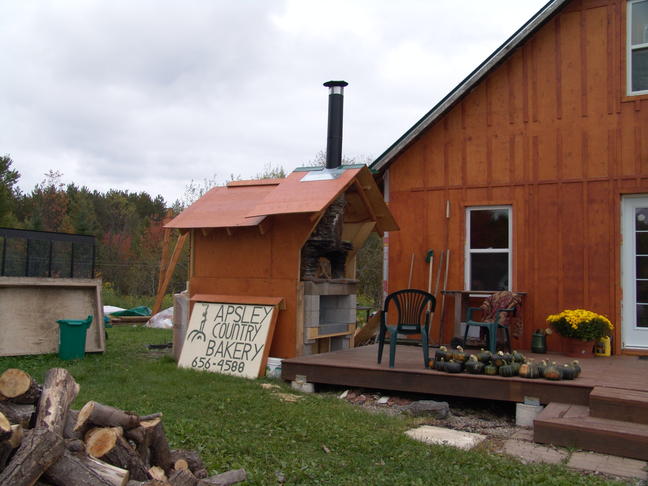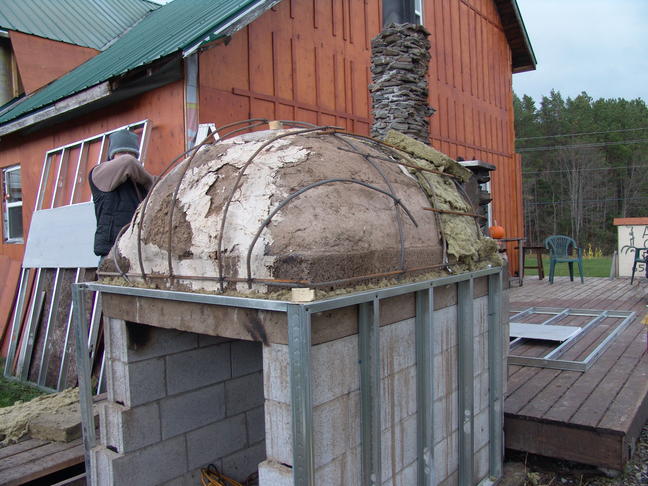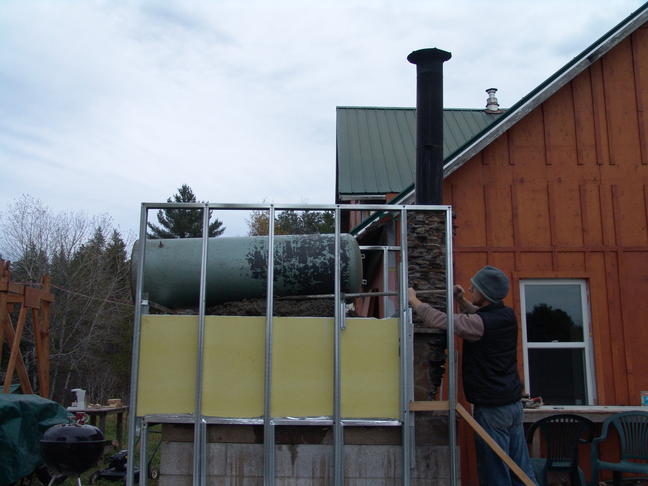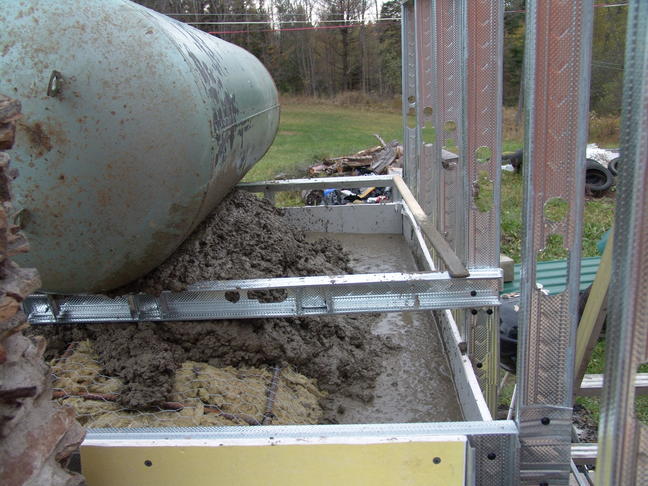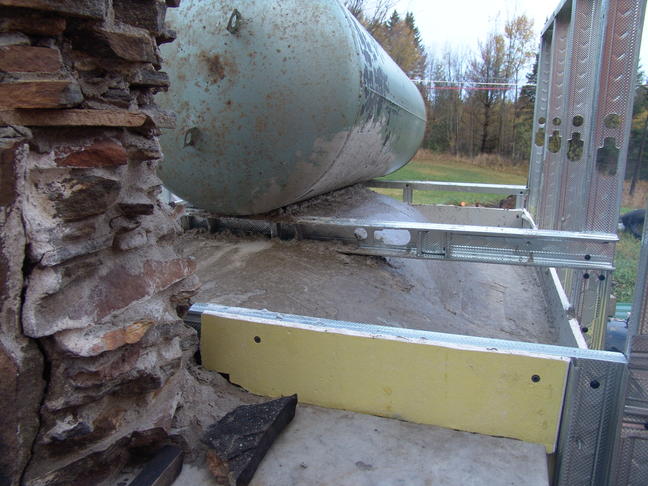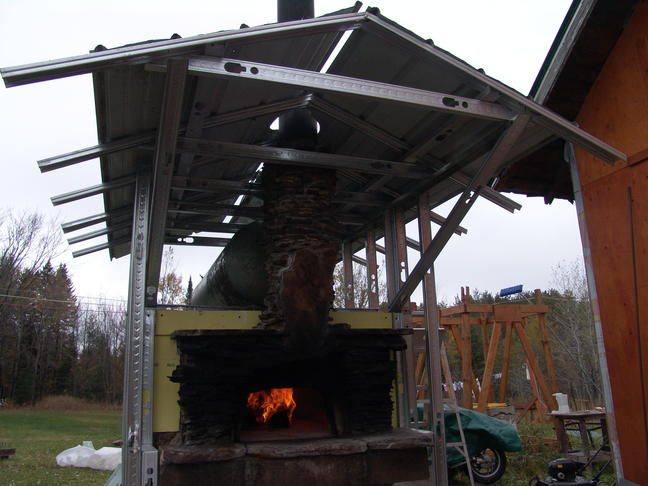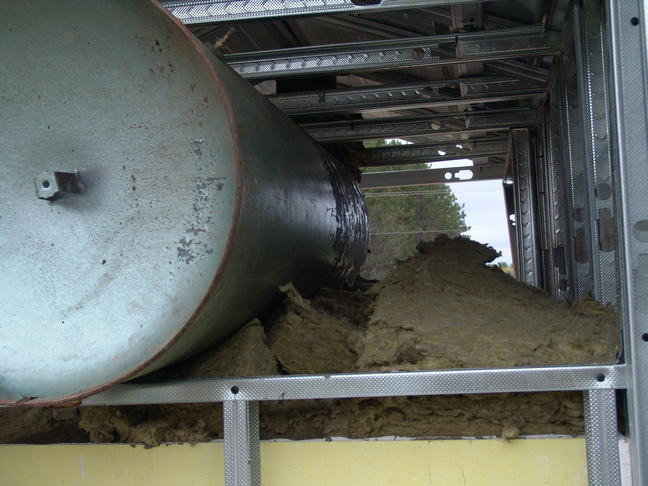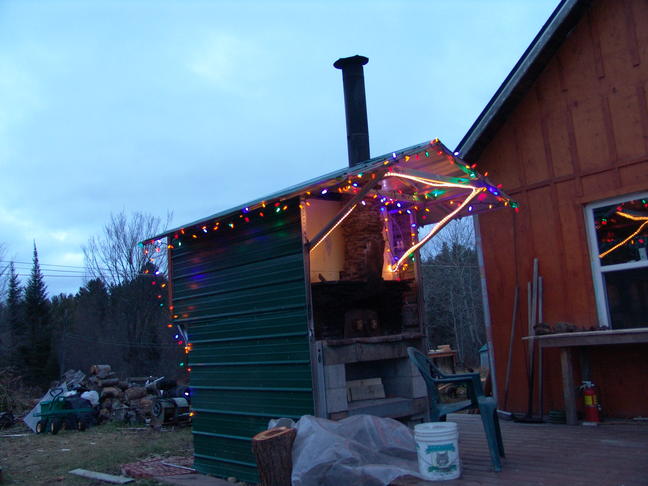The oven was great, but I wanted to make it better:
As the heading states I was very happy with the performance of the oven the first year however there were improvements and modifications that I thought would be worth the effort. At the end of the busy summer season we closed the bakery for a couple of weeks so I could cool the oven off and tear it apart.
Primarily what I wished to achieve was an increase in thermal mass so that our, single fire, baking capacity could be increased. Throughout this first full summer it became clear that we could not bake more than about 70 loaves of bread in a single firing of the oven. My aim is to increase that to about 100 loaves in a single fire.
A secondary objective is to capture some of the waste heat that is radiating from the exterior of the concrete shell. When the oven is up to a good full heat the exterior is well above 100 F. and it rarely drops below that. My thinking is that I can put a water tank on top of the oven shell and heat water. Not only will we then recover some waste heat but I believe the tank of hot water will act as a buffer for the oven, slowing the cooling of the interior of the oven. I do have to keep in mind that the primary purpose of the oven is to bake bread, not heat water. Thus I don't want to water tank to draw too much heat out of the oven.
Primarily what I wished to achieve was an increase in thermal mass so that our, single fire, baking capacity could be increased. Throughout this first full summer it became clear that we could not bake more than about 70 loaves of bread in a single firing of the oven. My aim is to increase that to about 100 loaves in a single fire.
A secondary objective is to capture some of the waste heat that is radiating from the exterior of the concrete shell. When the oven is up to a good full heat the exterior is well above 100 F. and it rarely drops below that. My thinking is that I can put a water tank on top of the oven shell and heat water. Not only will we then recover some waste heat but I believe the tank of hot water will act as a buffer for the oven, slowing the cooling of the interior of the oven. I do have to keep in mind that the primary purpose of the oven is to bake bread, not heat water. Thus I don't want to water tank to draw too much heat out of the oven.
|
The before and after pictures don't tell you too much, the overall design hasn't changed much.
First of course we had to tear apart all the nice work we had done to make the outside look nice. I say we because I was fortunate to have my son's company, he took some time off work to help. That's my handsome boy on the right. Have I mentioned he's single? |
Our poor oven looks so, naked, all stripped down. You may just notice that there are coals burning in the oven. I kept the oven somewhat warm throughout the renovation. When it came to pour new concrete I heated it up some more, to expand the existing shell so that it would be at its maximum size, more or less, before the new shelf was poured over it.
|
|
What I elected to do is repeat the same steps I did when preparing the initial concrete layer. I had originally considered pulling the original concrete layer, exposing the firebrick and pouring a new, thicker shell. Upon reflection that seemed counter-productive, since the original layer was working fine. As well exposing the firebrick could have lead to damage to the brick.
There is a new layer of tinfoil, then some roxul insulation for an expansion buffer, then rebar and chicken wire. |
We elected to use steel stud for the frame/form. It's fireproof. We used cement board for the form and it only needed to go as high as the new concrete layer would be. In this case the cement board would be permanent.
|
|
Once the walls/forming are in place and the water tank was positioned we could start pouring cement.
The tank is an old pressure tank that was given to me. It's very solid and while I will be heating it I'm not intending to pressurize it. I'll feed water to it from the house and use a circulating pump, likely something like a pond pump, to move the warm water where I want it. |
|
As you can see to the right, the tank isn't in contact with much of the concrete. As mentioned at the beginning I didn't want to draw too much heat from the oven. In addition once the tank is surrounded by insulation the tank will absorb a bunch of the radiant heat.
I smoothed the concrete to reduce the surface area, slowing the cooling rate. Once the concrete was pour we could finish the framing. We insulated the walls and covered the tank with insulation. |
|
You'll see above that there is a fire in the oven. As the cement cured I increased the heating to quicken the cure and to maintain the maximum expansion of the underlaying layers, as the concrete set.
I almost got ahead of myself with insulating around the water tank. I forgot to account for the moisture in the concrete and under the insulation it was quite wet. I had to pull the insulation out for a couple of days. While the metal covering isn't quite as pretty as the stained wood, it was extra steel roofing that I had, so it looks terrific, right ;-) The christmas light help and I brought electricity out to the oven so I could add some directional light. Particularly in the winter the inside of the oven gets quite dark. Now I need to spend a bunch of time re-learning how to fire the oven. With the previous configuration, while I kept the oven warm all the time, on the off days I just put a maintenance fire in. The on bake days there would be a vigorous fire each day. Now, I believe I need to fire the oven very hot on the off days to build a good body of heat and on bake days do the maintenance fires. |
|
Next up, I want to re-work the oven opening and put in a better door that's hinged. I'm thinking of using a glass door from a wood stove, just need to find one the right shape and size.
In the oven management section of the site I am planning on posting the stats on oven performance. I've kept fair good records of the first years firing and baking schedule and hope to chart the data. I'll be doing the same for the new oven configuration as well so we can see the differences and hopefully see that the new configuration gives me the outcome I was after. |
